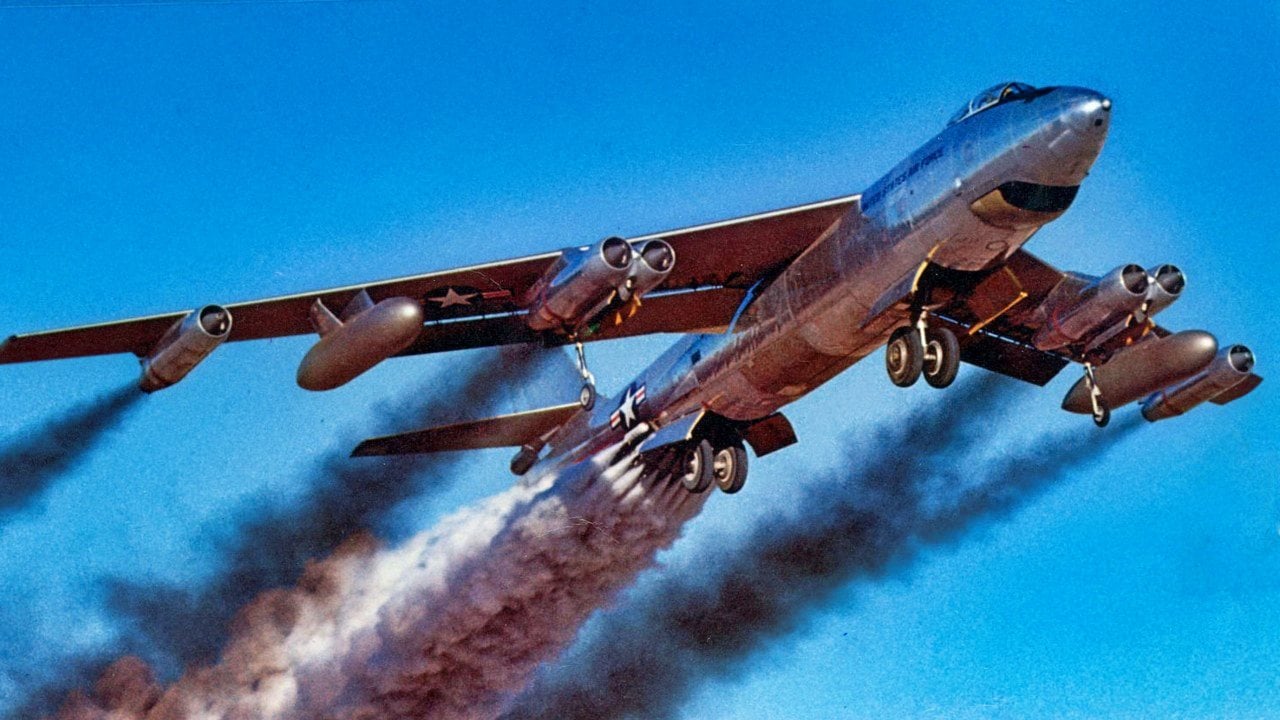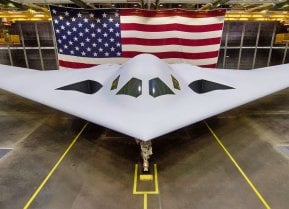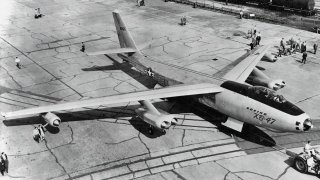Boeing B-47 Stratojet: America's First Jet Bomber That Broke All the Rules
The Boeing B-47 Statrojet was the first pure jet strategic bomber; yes, the B-36 did have four General Electric J47 turbojet engines, but six piston-driven engines outnumbered them.
Meet the B-47: The Boeing B-47 Statrojet was the first pure jet strategic bomber; yes, the B-36 did have four General Electric J47 turbojet engines, but six piston-driven engines outnumbered them.
In the B-47's case (not to be confused with the P-47 Thunderbolt), we're talking six of those same J47 (appropriately but purely coincidentally) turbojets; a two-engine, pylon-mounted pod under each wing near the fuselage; and a single-engine pod further outboard. In addition, the Stratojet was the nation's first swept-wing multi-engine bomber.
As noted by the Boeing fact sheet on the warbird:
"It represented a milestone in aviation history and a revolution in aircraft design. Every large jet aircraft today is a descendant of the B-47. Boeing engineers had envisioned a jet-powered plane as early as 1943. However, wind tunnel tests of straight-wing jet aircraft indicated that the straight wing did not use the full potential of jet-engine power … Another innovation pioneered on the B-47 was the concept of placing the engines in pods (nacelles) suspended under the wings."
B-47 Statrojet: The Key Details
The Stratojet made her maiden flight on December 17, 1947, and officially entered U.S. Air Force service in June 1951. Compared with the Peacemaker that preceded her, the Stratojet was relatively small in physical size and crew size.
The plane typically hosted a crew of three: pilot, copilot — who operated the tail turret by remote control — and an observer who also served as navigator, bombardier, and radar operator.
By contrast, the Peacemaker had a crew of 13! The B-47 was outright dwarfed by the B-36 in terms of wingspan and maximum takeoff weight: the former had a wingspan of 116 feet (35.36 meters) and a max takeoff weight of 221,000 pounds (100,244 kilograms) including a 25,000-pound (11,340-kilogram) bomb load; for the latter, a 230-foot (70.1-meter) wingspan — which means that the B-36 still holds the title for the longest wingspan of any combat aircraft — and a max takeoff weight of 410,000 pounds (185,973 kilograms) including an 86,000-pound (39,009-kilogram) bomb load.
The area where the B-47 beat the B-36 by a country mile was speed (not surprising in light of that aforementioned pure jet factor): 607 mph (977 kph/527 knots) vs. 435 mph (700 kph/378 knots). Thus the B-47 became the backbone of the SAC medium-bomber fleet. Designed to drop nuclear weapons on the Soviet Union from high altitude, tactics were later adapted to use a fighter-type "bomb toss" technique at a low level, thus embodying the USAF tenet of "Flexibility is the key to airpower."
As far as the flying qualities of the Stratojet in the eyes of the men who flew her, I'll provide you with this 1949 quote from test pilot Robert Robbins: "The best way to tell about the performance of the Stratojet is to say that any good crew could have flown it. It took no unusual ability or education. Neither Scott Osler nor I deserve any credit for the flight. Rather, the credit should go to the men who carried out these visions on the drafting boards and the factory workers who made the visions a reality."
Stratojet Struts Her Stuff for Hollywood
The B-47 never did get to see combat, in spite of being in service during the Korean War and Vietnam War alike. However, the plane still made some rock-solid contributions to the Cold War effort.

As noted by The Aviation Geek Club's Dario Leone:
"In addition to its role as a nuclear strike bomber, the Stratojet’s speed and payload made it a useful strategic reconnaissance aircraft. Between 1952 and 1956, photographic reconnaissance B-47s conducted several overflights of the Soviet Union, providing detailed pictures of Soviet military and industrial facilities. Stratojets gathered intelligence about Soviet air defense systems and the Soviet intercontinental ballistic missile program. Weather reconnaissance versions of the B-47 not only collected weather data, but also took air samples of Soviet nuclear detonations. These essential RB-47 missions over and along the border of the Soviet Union were hazardous, and Soviet fighters damaged one reconnaissance Stratojet and shot down two, with the loss of seven USAF personnel killed and two temporarily imprisoned."
Moreover, the bomber still attained some degree of immortality in the eyes of Hollywood movie audiences, thanks to the 1955 motion picture Strategic Air Command, starring the iconic Jimmy Stewart, Harry Morgan (in his pre-M.A.S.H. days), and the lovely June Allyson. In this film, Mr. Stewart portrays Col. "Dutch" Holland, a reactivated Air Force Reserve officer who hasn't been in the cockpit since his B-29 Superfortress days in WWII and now must adjust to the Jet Age.
"Dutch" flies a B-36 in the first half of the movie and a B-47 in the second half. Stewart's performance is given an additional air (bad pun intended) by his real-life status as a USAF Reserve Officer and a bomber pilot to boot; he received two Distinguished Flying Crosses for his WWII service and eventually retired at the rank of Brigadier General.
Where Are They Now?
A total of 2,042 B-47s were built before being phased out in 1965 and retired altogether in 1969. Twenty-three of them survive today, on display at museums such as the Museum of Flight in Seattle, Washington, the National Museum of the Mighty Eighth Air Force in Pooler, Georgia, and the Grissom Air Museum in Peru, Indiana.
About the Author
Christian D. Orr is a former Air Force officer, Federal law enforcement officer, and private military contractor (with assignments worked in Iraq, the United Arab Emirates, Kosovo, Japan, Germany, and the Pentagon). Chris holds a B.A. in International Relations from the University of Southern California (USC) and an M.A. in Intelligence Studies (concentration in Terrorism Studies) from American Military University (AMU). He has also been published in The Daily Torch and The Journal of Intelligence and Cyber Security. Last but not least, he is a Companion of the Order of the Naval Order of the United States (NOUS).


